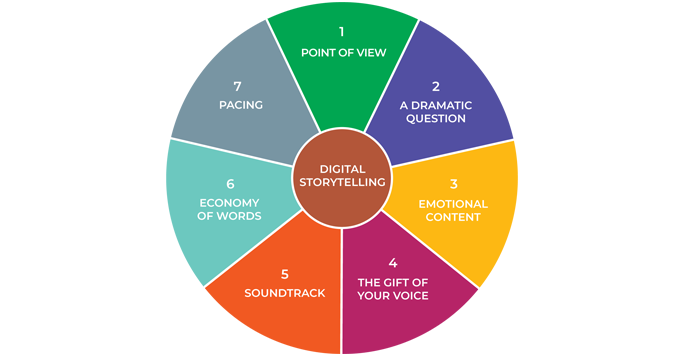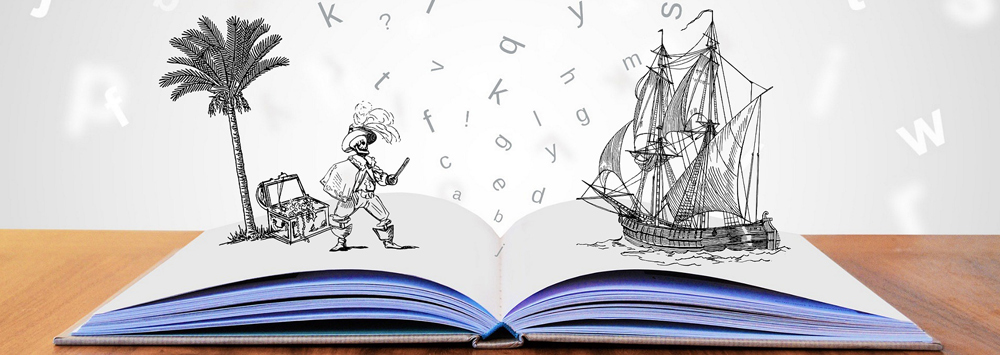Benefits
Students gain skills in five different literacies (Robin, 2008, p.224):
- Digital. Discuss issues, gather information, and seek help with a community.
- Global. Read, interpret, respond, and contextualise messages from a global perspective.
- Technology. Use technology to improve learning, productivity, and performance.
- Visual. Understand, produce, and communicate through visual images.
- Information. Find, evaluate, and synthesize information.
Putting it into practice
The following steps describe the process of digital story creation:
- Decide on the purpose and point of view.
- Develop a script.
- Storyboard.
- Record the story.
- Combine audio and visual elements.
- Add a credits screen.
- Incorporate music, titles, transitions, and effects.
- Publish final version.
Digital storytelling can be implemented as a formative or summative assessment (Jenkins and Gravestock, 2013). For example, in a 12-week period of teaching, a formative task could be embedded half way through the module as a ‘story circle’, a type of group work to facilitate group discussion. The benefits of ‘story circles’ include peer feedback and sharing and reflection on research and resources (e.g. texts and images). At the end of the 12-week teaching period, students would be tasked with the submission of a final digital story, in which they make use of the resources and ideas shared during their ‘story circle’ session.
To truly put digital storytelling into practice, consider Lambert’s (2013) seven elements framework for developing an engaging learning experience for students. This framework involves:

Point of view
The core message communicated in the story.
A dramatic question
Creates suspense and grabs the attention of the viewer or listener.
Emotional content
People like stories that are “real” and that make use of attractive language.
The gift of your voice
Reach out to the people through the sound of your voice.
Soundtrack
Not essential, but when done right, it can have a powerful impact.
Economy of words
Great stories are often just 200 to 300 words.
Pacing
Use the natural variations of a regular speaking voice, but varied in tempo and tone.
Challenges
- Assessment. Make sure the assessment is constructively aligned with the learning outcomes of your module, and that rubrics assess disciplinary knowledge over other aspects of the final product (e.g. media).
- Purpose. When creating a digital story, it is important to have a clear idea of its purpose. Stories that inform or instruct are the most frequently used type of stories for the purposes of the HE education context (Robin, 2006).
- Script writing. Creating a digital story is not about the technology, but about how well the elements of the digital story are applied, and the quality of the written story (Robin and McNeil, 2012).
- Technology. Choose a technology that you and your students feel comfortable with. There is a wide variety of video creation tools such as Adobe Spark video, iMovie maker and Powtoon.
References
Gottschall, J. (2012). The storytelling animal: How stories make us human. Houghton Mifflin Harcourt.
Jenkins, M., and Gravestock, P. (2013). Digital storytelling as an alternative assessment. In L. Clouder, C. Broughan, S. Jewell, G. Steventon, (Eds.) Improving student engagement and development through assessment: theory and practice in Higher Education. London: Routledge.
Lambert, J. (2013). Digital storytelling: Capturing lives, creating community. London: Routledge.
Robin, B. (2006). The educational uses of digital storytelling. Proceedings of Society for Information Technology and Teacher Education International Conference 2006. Edited by: Crawford, C. pp.709–16. Chesapeake, VA: AACE.
Robin, B. R. (2008). Digital storytelling: A powerful technology tool for the 21st century classroom. Theory into practice, 47(3), 220-228.
Robin, B.R. and McNeil, S.G. (2012). What educators should know about teaching digital storytelling. Digital Education Review, 22, pp.37-51.
Salpeter, J. (2005. Telling Tales with Technology: Digital Storytelling Is a New Twist on the Ancient Art of the Oral Narrative. Technology & Learning, 25(7), p.18.
Help and Feedback
Can you help us improve this resource or suggest a future one? Do you need this resource in an alternative format? Please contact us at cie@liverpool.ac.uk

Digital Storytelling by Dr. Monica Chavez Munoz is licensed under a Creative Commons Attribution-NonCommercial 4.0 International License.
